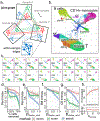Joint analysis of heterogeneous single-cell RNA-seq dataset collections
- PMID: 31308548
- PMCID: PMC6684315
- DOI: 10.1038/s41592-019-0466-z
Joint analysis of heterogeneous single-cell RNA-seq dataset collections
Abstract
Single-cell RNA sequencing is often applied in study designs that include multiple individuals, conditions or tissues. To identify recurrent cell subpopulations in such heterogeneous collections, we developed Conos, an approach that relies on multiple plausible inter-sample mappings to construct a global graph connecting all measured cells. The graph enables identification of recurrent cell clusters and propagation of information between datasets in multi-sample or atlas-scale collections.
Figures


References
Methods-only References
-
- Xin Y et al. Pseudotime Ordering of Single Human beta-Cells Reveals States of Insulin Production and Unfolded Protein Response. Diabetes 67, 1783–1794 (2018). - PubMed
Publication types
MeSH terms
Grants and funding
LinkOut - more resources
Full Text Sources

